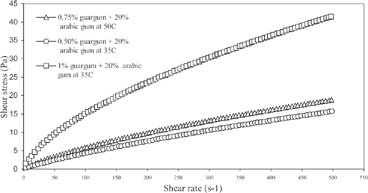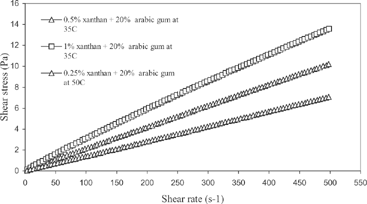Abstract
A rheological characterization of combination guar and xanthan gum with 20 kg/100 kg sample arabic gum was performed at 20 to 80°C by the application of the response surface methodology using an advanced controlled rate rheometer. The guar and xanthan gum concentrations employed were 0.25-1.25 kg/100 kg sample. The flow of both combinations was adequately described by Herschel-Bulkley model over the shear rate range of 0-500 s−1. The combination of arabic-guar exhibited shear-thinning behavior while arabic-xanthan combination behaved as a dilatants fluid with yield stress. A quadratic model developed for rheological parameters met all the criteria of good fit and provided useful information. It was observed that temperature and concentration affected yield stress, consistency coefficient and apparent viscosity (P<0.05) of gum combinations however, flow behavior index did not. The concentration of gum significantly (P<0.05) affected all the rheological parameters and temperature was the least. Addition of arabic gum significantly (P<0.05) reduced rheological properties of both guar and xanthan gum.
Introduction
The rheological behavior and flow properties of hydrocolloids have a significant role in the food industry as they govern the product development, design, and evaluation of the process equipment such as pumps, piping, heat exchangers, evaporators, sterilizers, and mixers.[Citation1]Rheological measurements have also been considered as an analytical tool to provide fundamental insights on the structural organization of food. In many products, especially artificially sweetened foods, hydrocolloids/gums have substituted sugars and the rheological properties govern the quality of end product. The common property of gums is that it imparts viscosity or thickening to aqueous solutions or dispersions. The degree of thickening depends on the type of gum and the level of concentration. The flow behavior or rheology of gums, as well as liquid systems, can be correlated with the sensory properties of the solution and, thereby, acceptability of the products. The rheological properties of gums could be a useful tool to formulate specific foods.
Gum arabic, the natural exudates from Acacia Senegal, a high molecular weight heteropolysaccharide (hydrolysis results D-galactose with lesser amount of L-arabinose, D-glucoronic acid, L-rhamnose and small amount of 4-O-methyl-D-glucoronic acid), shows unusual solution behavior compared to other polysaccharides of similar molecular weight.[Citation2] The rheology of arabic gums has been extensively studied. Gum solution above 30% shows higher solution viscosity and exhibits pseudoplasticity.[Citation3,Citation4] Some reports are available on shear thickening behavior of arabic gums while recently Mothe and Rao[Citation5] reported that the gum shows shear thinning behavior at low shear rate (1-50 s−1). The instrumental measurement of low viscosity fluids like arabic gum solutions has been a difficult task; however, with the advent of controlled stress rheometer, it is now possible to characterize the exact flow behavior of fluids with viscosities less than 1mPa.s[Citation6]. The reports on the rheology of arabic gums are contradictory and need further investigation.
Xanthan gum, a microbial heteropolysaccharide, composed of 1-4-linked β-D-glucose and Guar gum (Cyamposis teragonolobus), is a member of galactomannan family that contains 1-4 linked β-D-mannose and exhibit pseudoplasticity and thixotropy with high viscosity at low concentration.[Citation7,Citation8]
Presently, considerable attention has been given to the study of various hydrocolloids and their combinations for thickening and texture modification in gravies, dairy products, food drinks, and pet foods because their rheological and functional properties are complimentary. Recent applications have proved that such blends can produce new food formulations and ingredients. Gum arabic is compatible with most other gums due to its low viscous characteristics. The structure of gum Arabic contains proteinaceous material (2%) covalently joined with polysaccharide moiety.[Citation9] It gives a smooth flow or sometimes reduces high viscosity in combination with other gums like xanthan, gelatin, agar, guar gum, and modified starches to produce various confections. The gum has been beneficial when a thin, pourable consistency is desired. The synergic effects of arabic gum have also interested the food processing industries. The resulting rheological properties of various gums depend on the gum concentration, molecular weight of the polysaccharides and functional groups, and the degree of interaction between the two hydrocolloids. Associations of participating hydrocolloids occur if biopolymers the interaction is favorable while mixture of two repulsive hydrocolloids exhibits thermodynamic incompatibility.[Citation10–12] Several studies have been reported on rheological characteristics of food hydrocolloids individually or in food formulations[Citation11–19] Various gum combinations have also been reported to improve the stability of emulsion.[Citation20] However, rheological behavior of guar and xanthan gum with arabic gum has not been studied extensively.
The response surface methodology (RSM) is an empirical modellization statistical technique[Citation21] used to find the optimum condition of a process response variable when the mechanism underlying the process is either not well understood or is too complicated to allow the exact model to be formulated from theory. It evaluates the relation existing between a group of controlled experimental factors and the observed results of one or more selected variables.[Citation22] The central composite rotatable design (CCRD) has the advantage to predict responses based on selected experimental data that all factors are varied within a chosen range. Numerous applications of the RSM technique in food processing and research are available in the literature.
In the present work, an attempt was made to study the synergic rheological effects of guar and xanthan (0.25 to 1.25 kg/100 kg sample) with arabic gum (20 kg/100 kg sample) at a temperature range of 20-80°C using a response surface methodology.
MATERIALS AND METHODS
Materials
Arabic gum, guar gums were purchased from Sigma (St. Louis, MO, USA) while xanthan gums procured from Kelco (Merck & Co. IL, USA) respectively.
Experimental Design
Response surface methodology was selected to investigate the main effect of the process variables on rheological characteristics of arabic gum, dispersion of arabic-guargum, and arabic-xanthan gum. The experimental design was adopted was a modified configuration of Box's central composite design (CCD) for two variables at five levels each (). The two independent variables or factors, temperature (X1) and concentration (X2), were selected to optimize responses yield stress (Y1), consistency index (Y2), flow behavior index (Y3), and apparent viscosity (Y4). The complete design included 16 experiments with 8 replications of the center point () and was rotatable as described by Draper.[Citation23] The relationship between coded variables and practical variables were as follows: X1= (T-50)/15 and X2 = (C-0.75) × 4.
Table 1 Variables and levels for a rotatable central composite design used in arabic –guar gum and arabic-xanthan gum combination rheology experiments
Table 2 Central composite rotatable design arrangement and responses
Sample Preparation
Blends of guar and xanthan with Arabic gum were prepared as per the design described in . The desired amount of guar gum needed to produce 0.25 to 1.25 kg along with 20 kg of arabic gum were measured and slowly dispersed in deionized water (conductance: 18 Ω, Milli-Q, Millipore, Bedford, USA) to produce 100 kg dispersed solutions under stirring at room temperature (18-20 °C) and kept for 18 h for hydration. Similarly, a dispersed solution of xanthan and arabic gums was also prepared. The dispersions were centrifuged (Centrifuge, Model GS-6, Palo Alto, CA) at 1000 × g for 5 min to remove entrapped air bubbles. Dispersions were prepared in duplicate.
Rheological Measurement
Rheological measurements were carried out in a controlled rate rheometer (AR 2000, TA Instruments, New Castle, DE, USA) with attached computer software (Rheology Advantage Data Analysis Program, TA), as earlier described by Ahmed and Ramaswamy[Citation24] for xanthan gum rheology. A conical end (DIN) (rotor radius 14 mm; stator radius 15 mm; immersed height 42 mm and gap 5920 microns) was used. The instrument was set at zero-gap before actual measurement. The AR 2000 Concentric Cylinder System is based on efficient peltier temperature control. Temperature was efficiently monitored (±0.1°C) during the experiments.
For each test, approximately 19.6 mL sample was transferred to sample compartments. The instrument was programmed for set temperature and equilibration for 15 min followed by two-cycle shear changes from 0 to 500 s−1 for combinations in 5 min and by back to 0 s−1 in next 5 min. All the rheological parameters were obtained from the software (Rheology Advantage, TA version 2.3). In order to perform a quantitative comparison of gum solutions, various rheological flow models based on shear stress-shear rate were tested (Newton, Bingham, Casson, power law, Herschel Bulkley) (
), and the best fit model was selected on the basis of standard error, which is defined as:
Table 3 Fitting of various flow models based on standard errors
Where Xm is the measured value, Xc is the calculated value; n is the number of data points and range is the maximum value of Xm – the minimum value. A standard error value less than 20 was considered as a best-fit model (Rheology Advantage, TA Version 2.3).
Polynomial Equations and Statistical Analysis
A quadratic polynomial regression model was assumed for predicting individual Y variables. The model proposed for each response of Y is:
where bo is a constant and bi, bii, and bij are regression coefficients of the model and Xi and Xj are the independent variables in coded values.
The regression analysis, analysis of variance (ANOVA), canonical analysis, and analysis of ridge maximum of data were carried out using the RSREG procedure of the SAS statistical package[Citation25] to fit second order polynomial equations for all response variables. Response surfaces were made by the fitted quadratic polynomial equation obtained from RSREG analysis, holding the independent variables with the least effect on the response at a constant value and changing the other two variables. Conformity experiments were done to validate the equation, using the combination of independent variables, which were not included in the original experimental design and within the experimental region. Lack-of-fit tests were performed on the fitted models. Coefficients for the linear, quadratic, and interaction terms of each model were calculated and tested from zero. The criterion for eliminating a variable from the full regression equation was based on R2 values, standard error to estimate (SE) and significance F-test and the derived P values.[Citation26]
Three dimensional response surface plots were generated by using Sigma plot software (Sigma Plot 2000; SPSS Inc.) to illustrate the main and interactive effects of the independent variables.
RESULTS AND DISCUSSION
Flow Models
Shear stress-shear rate data of the arabic, guar, xanthan, arabic-guar (AG) and arabic-xanthan (AX) were tested for various rheological models, and it was found that Herschel Bulkley model was fitted adequately with minimum standard errors (). The Herschel Bulkley model is represented as:
where τ is the shear stress (Pa), τo is the yield stress, γ is the shear rate (s−1), K is the consistency index (Pa.sn), and n is the flow behavior index (dimensionless). A solution of 20% arabic gum at 20°C exhibited considerably low yield stress (4.86 × 10−3 Pa), while 0.75% xanthan solution showed maximum yield (3.73 Pa) followed by guar gum (0.342 Pa). The consistency coefficient, flow behavior index, and apparent viscosity of all individual gums are presented in . The typical rheograms of AG and AX are shown in and , respectively.
Table 4 Comparative studies on rheological parameters of individual gum and combinations at 20°C.
Regression models of rheological parameters (τ0, K, n and η)
Temperature has an important role on rheological characteristics of hydrocolloids. The effect of temperature on rheological characteristics at constant shear rate is expressed by the Arrhenius relationship,[Citation1,Citation27] while the effect of concentration on apparent viscosity of hydrocolloids is described by either an exponential or power relationship.[Citation27] From a practical standpoint, it will be more relevant to describe the effects of temperature and gum concentration on flow characteristics by a combined model. Several authors[Citation15,Citation28] have used the combined effect of temperature and concentration on consistency index/apparent viscosity to describe the flow behaviour of hydrocolloids. In this study, τ0, K, n, and η were related to temperature and concentration by a multiple regression analysis.
The effects of treatment variables as linear, quadratic, or interaction coefficients on response variables were obtained by analysis of variance. Significance of the lack-of-fit error term, R2 value, coefficient of variation (CV), and model significance were used to judge adequacy of model fit. The predictive models developed for Y1 (yield stress), Y2 (consistency coefficient), Y3 (flow behavior index), and Y4 (apparent viscosity) of AG and AX were considered adequate because they possessed no significant lack of fit and had satisfactory level of R2, CV, and model significance. It is evident from that all linear and one quadratic terms were found to be significant (P<0.05) for Y1 of both AG and AX. Similarly, all linear and one quadratic terms of Y2 were significant for AG while the linear term was only significant for AX. The R2 values were greater than 0.79 for both Y1 and Y2 with a standard error less than 0.16. The contribution for linear, quadratic, and cross products terms to the model was 0.776, 0.154, 0.020, and 0.641, 0.210, 0.049 for Y1 and 0.684, 0.236, 0.016 and 0.775, 0.009 and 0.004 for Y2 of AG and GG, respectively. The linear term (gum concentration) of Y3 only was significant for AG and GG. The contribution for linear, quadratic, and cross products terms to the model was 0.908, 0.010, 0.003 and 0.475, 0.189, 0.065 for Y3 of AG and GG respectively. The coefficients of determination were 0.92 and 0.73 for AG and AX, respectively, and standard errors were less than 0.038. All the regression terms of AG were significant (P<0.05) for Y4 while the interaction term was insignificant (P>0.05) for AX. The R2 values were greater than 0.91 for both AG and GG while the standard error was less than 0.002. The linear contributions for the model were 0.842 and 0.747; quadratic and cross products terms were 0.112; 0.020 and 0.157; 0.009 for AG and GG, respectively. The fitted equations were obtained considering only significant terms to predict Y1 (τ0), Y2 (K), Y3 (n), and Y4 (η) values and are shown in .
Table 5a Regression coefficients and analysis of variance of the regression models for rheological parameters of AG
Table 5b Regression coefficients and analysis of variance of the regression models for rheological parameters of AX
Table 6 Regression equations of rheological parameters for different combinations of gums
Effects of temperature and concentration on τ0
The model [Eq. (4) and (8)] indicated that concentration (X2) had significant effect on yield stress (Y1), as it had a larger magnitude than that of temperature (X1). These observations were also verified from canonical analysis of response surface. However, negative coefficients of X1 indicated a linear effect to decrease Y1 while X2 and its quadratic term (X22) increased Y1. The three-dimensional figures ( ) show that the independent variables and their interactions with the predictive model for yield stress. These provide geometrical representation of the behavior of τ0 within the experimental design. The decrease in magnitude of yield was observed with increase in temperature while gum concentration increased the same amount. The yield stress of AG was found to be higher than AX; however, the individual yield of 0.75% xanthan was considerably higher (3.73 Pa) than that of 0.75% guar (0.342 Pa) at 20°C (). This indicated that the complex formation between arabic and guar gum required more force to initiate the flow. In the present study, the decrease in resulted yield for AX may be due to active participation of arabic gum. A solution containing xanthan generally undergoes a conformational transition under the influence of temperature, and possibly the presence of arabic gum enhanced thermal transition to ease the flow.
Figure 2a Effect of temperature and concentration of guargum on arabic gum-guar gum mixture on yield stress.
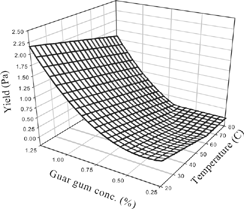
Figure 2b Effect of temperature and concentration of xanthan gum on yield stress of arabic gum-xanthan gum combination.
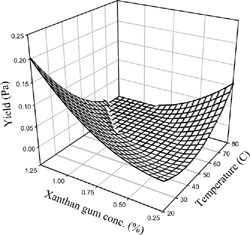
The optimum concentration to get minimum yield was calculated from partial derivatives of the quadratic response equation with respect to X2, setting the derivatives equal to zero. It was found that 0.39% guar gum concentration and 0.45% xanthan exhibited minimum yield. The eigen values obtained from the canonical analysis indicating that the stationary point is a saddle point.
Effects of temperature and concentration on K
Equations (5) and (9) represented the model. From those equations, gum concentration (X2) is shown to have a significant effect on consistency index (Y2) as it had a larger magnitude than that of temperature (X1) for AG while the reverse was true for AX. Canonical analysis of response surface supports the observations. However, negative coefficients of X1 indicated a decrease in the linear effect of Y2 while X2 and its quadratic term (X22) increased Y2. represents the independent variables and their interactions with the predictive model for consistency coefficient. The magnitude of K decreased with an increase in temperature while gum concentration significantly increased K. This observation was supported by earlier reports on hydrocolloids. [Citation12 Citation–13,Citation15] Xanthan exhibited stronger association with arabic gum compared to guar (). Recent work has proved that the emulsifying properties of arabic gum are solely dependent on arabinogalactan-protein complex and the glycoprotein.[Citation29]
Figure 3a Effect of temperature and concentration on consistency coefficient of arabic gum-guar gum combination.
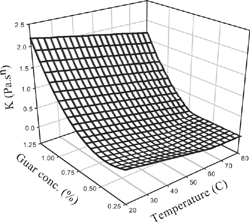
Figure 3b Effect of temperature and concentration on consistency coefficient of arabic gum-guar gum combination.
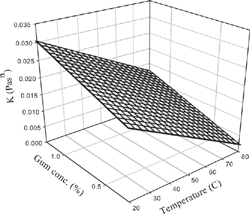
The optimum guar gum concentration was found to be 0.44% to get a minimum consistency coefficient. The eigen values obtained from the canonical analysis indicate that the stationary point is a saddle point for both AG and AX.
Effects of temperature and gum concentration on n
It is evident from equations 6 and 10 that Y3 (flow behaviour index) was dependent (P<0.05) solely on gum concentration. There was complete difference in the flow behavior of two studied combinations. The AG shows shear thinning behavior with n values in the range of 0.455 and 0.956 while AX exhibited dilatancy with n values ranged between 0.832 and 1.036. Both participating gums influenced the resulted n values for both AG and AX significantly (P<0.05) (). It could be predicted that the association between arabic and xanthan was stabilized due to presence of side chain of xanthan molecule and hydrogen bonding. [Citation8] This results the dilant characteristics of AX complex. Lack of side chain in the guar gum hindered the penetration of water and decreased solubility.
Effects of temperature and concentration on η
(Equations (7) and (11) showed that temperature (X1) and gum concentration (X2) individually and the quadratic terms of X1 and X2 significantly influenced the apparent viscosity (Y4). The negative coefficient indicated that a response variable decreased with an increase of that factor. No significant effect was noticed for interaction term of AX combination on Y4. The three-dimensional figures ( ) show the independent variables with the predictive model for apparent viscosity with its geometrical representation. Guar gum, which is a linear polysaccharide (mannose to galactose ratio of 2:1) and has less hydration characteristics at low temperature, exhibits less synergism to arabic gum compared to xanthan resulting in a higher apparent viscosity (). It has been reported that when galactomannans are in solution, the long mannan chain unfolds to form an open, flexible non-ordered conformation, and the coils are well separated at low gum concentration.[Citation30 Citation–31 Those chains move freely and could change their orientation within a dilute solvent domain. In this case, the protein part of arabic gum probably forms complexes with free chains of xanthan.
Figure 4a Effect of temperature and concentration on apparent viscocity of arabic gum-guar gum combination.
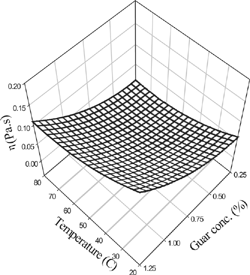
Figure 4b Effect of temperature and concentration on apparent viscocity of arabic and xanthan gum combination.
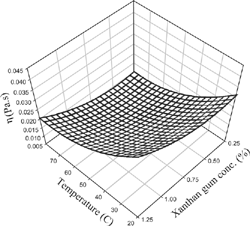
The viscosity of the complex increased with an increase in gum concentration. As concentration increases the polysaccharides chains move closer together, resulting in their mutual entanglement. In entanglement, domain viscosity increases exponentially.[Citation7] The temperature inversely affected the apparent viscosity of gums. The low viscosity was attributed to partial hydrolysis of gum. Various researchers have reported significant decreases in apparent viscosity during heat treatment.[Citation13,Citation32 Citation–33]
The optimum concentration to get minimum apparent viscosity was calculated from partial derivatives of the quadratic response equation with respect to X1 and X2, setting the derivatives equal to zero. The minimum apparent viscosity of AG was exhibited at 71.6°C temperature and 0.23% guar gum concentration while the corresponding values for AX were 74.7°C and 0.47%, respectively. The eigen values obtained from the canonical analysis indicates that the stationary point is at a minimum.
CONCLUSIONS
The response surface methodology (RSM) was effective to optimise the rheological behavior of Arabic-guar and arabic-xanthan gum complex and three-dimensional figures were well represented to identify the effects of temperature and concentration on rheological parameters. Good fit models were developed for yield stress, consistency coefficient, flow behaviour index, and apparent viscosity. Gum concentration contributed significantly on the rheology of arabic-guar and arabic-xanthan combinations. The combined flow behaviour was described well by the Herschael-Bulkley model, and gum complexes behaved as a pseudoplastic fluid with yield stress. Xanthan exhibited higher affinity to form complex with arabic gum and diluted the mix significantly (P<0.05).
REFERENCES
- Rao , M.A. and Anantheswaran , R.C. 1982 . Rheology of fluids in food processing. Food Technol. , 36 : 116 – 126 .
- Fennema , OR. 1985 . Food Chemistry , 125 – 134 . New York : Marcel Dekker, Inc. .
- Williams , P.A. , Phillips , G.O. and Randall , R.C. 1990 . “ Structure-function relationships of gum Arabic. ” . In Gums and Stabilizers for the Food Industry , Edited by: Phillips , GO , Williams , P.A. and Wedlock , D.J. 25 – 36 . Oxford : IRL Press .
- Wareing , M.V. 1997 . “ Exudate gums ” . In Thickening and Gelling Agents for Food , Edited by: Imeson , A. 86 – 118 . London, , UK : Blackie Academic & Professional .
- Mothe , C.G. and Rao , M.A. 1999 . Rheological behavior of aqueous dispersions of cashew gum and gum arabic: effect of concentration and blending. Food Hydrocolloids, , 13 : 501 – 506 .
- Schenz , TW . 1997 . Using rheology of weak gels to improve fluid foods. Food Technology, , 51 : 83 – 85 .
- Fox , J.E. 1997 . “ Seed gums ” . In Thickening and Gelling Agents for Food , Edited by: Imeson , A. London, , UK : Blackie Academic & Professional .
- Urlacher , B and Noble , O. 1997 . “ Xanthan gums ” . In Thickening and Gelling Agents for Food , Edited by: Imeson , A. London, , UK : Blackie Academic & Professional .
- Akiyama , Y. , Eda , S. and Kato , K. 1984 . Gum arabic is a kind of arabino-galactan protein. Agri. Biol. Chem , 48 : 235 – 237 .
- Tolstoguzov , V.B . 1991 . Functional properties of food proteins and role of protein-polysaccharide interaction. Food Hydrocolloids , 4 : 429 – 468 .
- Ould Eleya , M.M. and Turgeon , S.L . 2000 . Rheology of κ-carragennan and β-lactoglobulin mixed gels. Food Hydrocolloids. , 14 : 29 – 40 .
- Krumel , KL and Sarkar , N . 1975 . Flow properties of gums useful to the food industry. Food Tech. , 4 : 36 – 44 .
- Rao , M.A. , Walter , R.H. and Cooley , H.J . 1981 . Effect of heat treatment on the flow properties of aqueous guargum and carboxymethymethyl cellulose (CMC) solutions. J. Food Sci. , 46 : 496 – 498 .
- Abdelrahim , K.A. , Ramaswamy , H.S. and van de Voort , F.R . 1995 . Rheological properties of starch solutions under aseptic processing temperatures. Food Res. Int. , 28 : 473 – 480 .
- Marcotte , M. , Taherian , A.R. and Ramaswamy , H.S . 2001 . Rheological properties of selected hydrocolloids as a function of concentration and temperature. Food Res. Int. , 34 : 695 – 703 .
- Hemar , Y. , Tamehana , M. , Munro , P.A. and Singh , H . 2001 . Viscosity, microstructure and phase behavior of aqueous mixtures of commercial milk protein products and xanthan gum. Food Hydrocolloids. , 15 : 565 – 574 .
- Wang , F. , Sun , Z. and and Wang , Y.-J . 2001 . Study of xanthan gum/waxy corn starch interaction in solution by viscometry. Food Hydrocolloids , 15 : 575 – 581 .
- Buffo , R.A. and Reineccius , G.A . 2002 . Modeling the rheology of concentrated beverage emulsions. J. Food Engg. , 52 : 267 – 272 .
- Ibanoglu , E . 2002 . Rheological behavior of whey protein stabilized emulsions in the presence of gum Arabic. J. Food Engg. , 52 : 273 – 277 .
- Garti , N . 1999 . Hydrocolloids as emulsifying agents for oil-in-water emulsions. J. of Dispersion Science & Technology, , 20 : 327 – 355 .
- Myers , R.H. and Montgomery , D.C. 1995 . Response Surface Methodology , New York : John Willey & Sons, Inc. .
- Box , G.E.P. , Hunter , W.G. and Hunter , J.S. 1978 . Statistics for Experimenters , New York : John Willey & Sons, Inc. .
- Draper , N.R. 1982 . Center points in second order response surface designs. Technometrics. , 24 : 127 – 133 .
- Ahmed , J. and Ramaswamy , H.S . 2004 . Effect of high-hydrostatic pressure and concentration on rheological characteristics of xanthan gum. Food Hydrocolloids , 18 : 367 – 373 .
- SAS Institute,Inc. 1990 . SAS User's Guide Statistics, Version 5 , 4th , Cary, , NC : SAS Institute, Inc. .
- Ahmed , J. and Ramaswamy , H.S. 2004 . Response surface methodology in rheological characterization of papaya puree. Int. J. Food Prop. , 7 : 45 – 58 .
- Speers , R.A. and Tung , M.A. 1986 . Concentration and temperature dependence of flow behaviour of xanthan gum dispersions. J. Food Sci. , 51 : 96-98 – 103 .
- Dail , R.V. and Sreffe , J.F. 1990 . Rheological characterization of crosslinked waxy maize starch solutions under low acid aseptic processing conditions using tube viscometry techniques. J. Food Sci , 55 : 1660 – 1665 .
- Randall , R.C. , Phillips , G.O. and Willams , P.A. 1989 . Fractionation and characterization of gum arabic from Acacia Senegal. Food Hydrocolloids. , 3 : 65 – 75 .
- Mitchell , JR. 1979 . In: Polysaccharaides in Food Edited by: Blanshard , JMV and Mitchell , JR . 51 – 57 . Butterworth, London
- Morris , Erand Ross-Murphy . 1981 . SB. Chain flexibility of polysaccharide and glycoproteins from viscosity measurements. Techniq. Carbohydr. Metabol. B. , 310 : 1 – 46 .
- Elfak , AM , Pass , G , Phillips , GO and Morley , RG . 1977 . The viscosity of dilute solutions of guar gum and locust bean gum with or without added sugars. J Sci. Food Agric. , 28 : 895
- Autio , K. , Myllmaki , O. and Malkki , Y. 1987 . Flow properties of solutions of oat β-glucans. J. Food Sci. , 52 : 1364 – 1366 .
